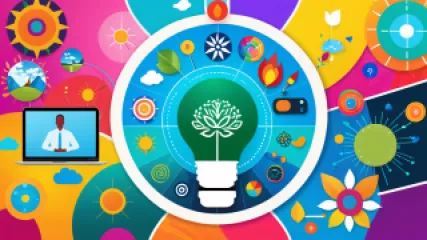10 Best Creative Therapy Ideas for Virtual Sessions
10 Best Creative Therapy Ideas for Virtual Sessions
In the ever-evolving world of mental health and wellness, the advent of virtual therapy sessions has presented both challenges and exciting opportunities. As the landscape of healthcare continues to shift, creative therapists have risen to the occasion, devising innovative ways to engage and support their clients remotely. In this comprehensive list, we'll explore 10 of the best creative therapy ideas that have proven effective in virtual settings, empowering both practitioners and individuals seeking emotional and artistic fulfillment.
1. Virtual Vision Boards
Vision boards have long been a staple in the realm of personal growth and goal-setting. In the virtual therapy space, this powerful tool can be elevated to new heights. Therapists can guide clients through the process of creating digital vision boards, utilizing online platforms, graphic design software, or even collaborative digital whiteboards. This allows for a more interactive and dynamic experience, where clients can curate images, affirmations, and symbols that represent their aspirations and desired outcomes. The virtual nature of this activity encourages clients to delve deeper into their inner landscapes, fostering self-reflection and a sense of empowerment as they bring their dreams to life on the screen.
2. Expressive Arts Journaling
The therapeutic benefits of journaling are well-documented, and in the context of virtual sessions, the practice can be enhanced through the integration of expressive arts. Therapists can encourage clients to engage in a variety of artistic modalities, such as drawing, painting, collage-making, or even digital art creation, as they express their thoughts, feelings, and experiences on the page. This multisensory approach allows clients to tap into their innate creativity, providing a powerful outlet for emotional processing and self-discovery. By sharing their journal entries or digital creations during the virtual sessions, clients can deepen their self-awareness and engage in meaningful discussions with their therapists.
3. Virtual Mindfulness Practices
Mindfulness has become a cornerstone of many therapeutic approaches, and the virtual setting offers unique opportunities to incorporate these practices. Therapists can guide clients through a range of virtual mindfulness exercises, such as guided meditations, body scans, or even virtual nature immersions. By leveraging technology, clients can access a variety of soothing and centering experiences, from 360-degree video tours of serene landscapes to interactive visualizations that promote relaxation and inner peace. These virtual mindfulness practices can be tailored to the individual needs and preferences of each client, empowering them to cultivate a deeper sense of presence and emotional well-being.
4. Interactive Storytelling
The power of storytelling has long been recognized in the field of therapy, and the virtual setting presents an opportunity to expand this modality. Therapists can engage clients in interactive storytelling exercises, where they collaboratively weave narratives, create fictional characters, or explore metaphorical landscapes. This approach encourages clients to tap into their imagination, fostering a sense of play and creative expression. Virtual tools, such as digital whiteboards or collaborative writing platforms, can facilitate this process, allowing clients to actively contribute to the story's development and gain new perspectives on their own experiences.
5. Virtual Art Exhibitions
Art has long been a powerful medium for self-expression and emotional exploration, and the virtual realm offers novel ways to engage with this modality. Therapists can curate virtual art exhibitions, showcasing works created by their clients or by renowned artists whose creations resonate with the therapeutic themes being explored. Clients can virtually "walk through" these digital galleries, immersing themselves in the visual representations of emotions, experiences, and inner landscapes. This activity not only nurtures the clients' appreciation for art but also provides a platform for thoughtful discussions, emotional processing, and the development of deeper self-understanding.
6. Virtual Scavenger Hunts
Scavenger hunts can be a playful and engaging way to foster creativity and connection in virtual therapy sessions. Therapists can design themed scavenger hunts, challenging clients to find or create specific items within their immediate environments. This activity encourages clients to think outside the box, explore their surroundings with fresh eyes, and tap into their problem-solving skills. As clients share their discoveries during the session, therapists can facilitate discussions that shed light on the clients' thought processes, coping mechanisms, and overall emotional state, ultimately strengthening the therapeutic relationship.
7. Virtual Artistic Collaborations
Collaboration can be a powerful tool for fostering connection and self-expression, even in a virtual setting. Therapists can facilitate virtual artistic collaborations, where clients work together to create shared works of art, such as digital collages, interactive murals, or collaborative stories. This activity not only encourages clients to engage in a creative process but also promotes teamwork, communication, and the exploration of interpersonal dynamics. As clients navigate the challenges and joys of collaborative creation, they can gain valuable insights into their own patterns of interaction, conflict resolution, and the art of compromise.
8. Virtual Emotion Wheels
Emotion wheels, or feeling wheels, are visual tools that can be particularly impactful in virtual therapy sessions. Therapists can utilize digital platforms to create interactive emotion wheels, where clients can explore a wide range of emotions, their nuances, and their interconnectedness. By engaging with these virtual tools, clients can deepen their emotional literacy, learn to identify and articulate their inner experiences, and develop more effective strategies for emotional regulation. The virtual nature of this activity allows for a level of exploration and self-discovery that may not be as easily accessible in a physical setting.
9. Virtual Embodied Practices
Embodied practices, such as yoga, dance, or somatic awareness exercises, can be seamlessly integrated into virtual therapy sessions. Therapists can guide clients through virtual movements and exercises that promote body awareness, emotional expression, and the integration of the mind and body. These virtual embodied practices can help clients connect with their physicality, release tension and stress, and cultivate a deeper sense of self-compassion and inner resilience. By engaging in these virtual embodied experiences, clients can gain valuable tools for self-regulation and personal growth.
10. Virtual Creative Challenges
Fostering a sense of playfulness and exploration can be a powerful approach in virtual therapy sessions. Therapists can introduce creative challenges, where clients are asked to engage in spontaneous, imaginative tasks, such as creating a short story based on a random word prompt, designing a unique character, or composing a piece of music using only household items. These challenges encourage clients to step outside their comfort zones, tap into their innate creativity, and approach problem-solving with a fresh perspective. By sharing their creations and the process behind them, clients can gain insights into their thought patterns, coping mechanisms, and the ways in which they navigate uncertainty and self-expression.
As the landscape of mental health and wellness continues to evolve, the integration of virtual therapy sessions has become increasingly prevalent. By embracing the opportunities presented by this medium, creative therapists can enhance the therapeutic experience, foster deeper connections with their clients, and empower individuals to explore the transformative power of artistic expression and emotional exploration. The 10 ideas outlined in this article offer a diverse array of approaches that can be tailored to the unique needs and preferences of each client, ultimately supporting their journey towards greater self-awareness, resilience, and overall well-being.






